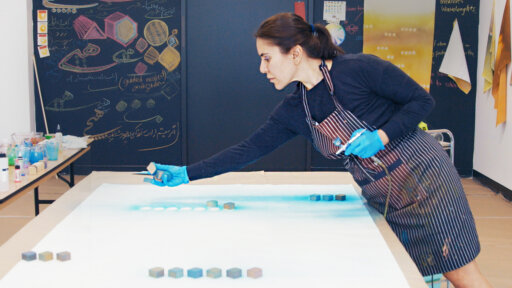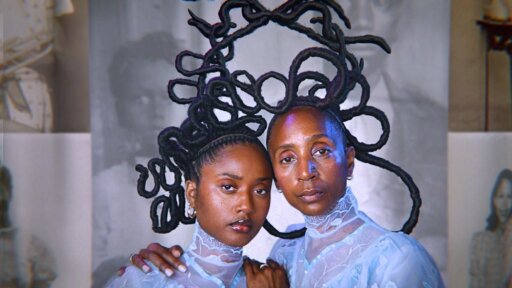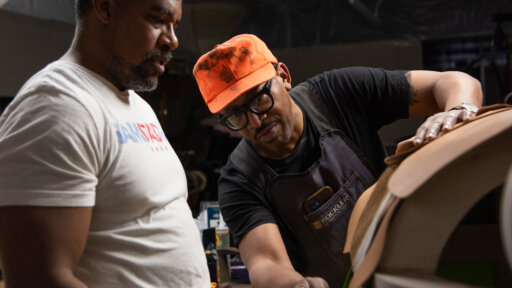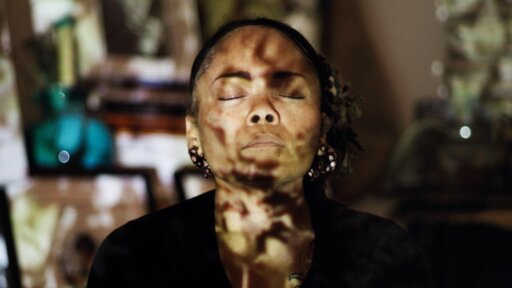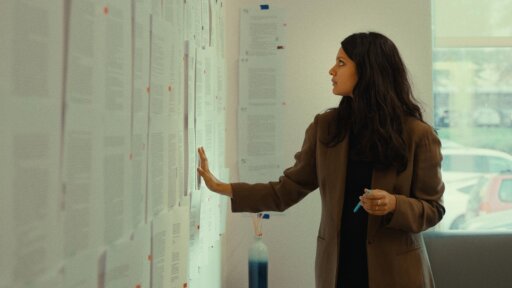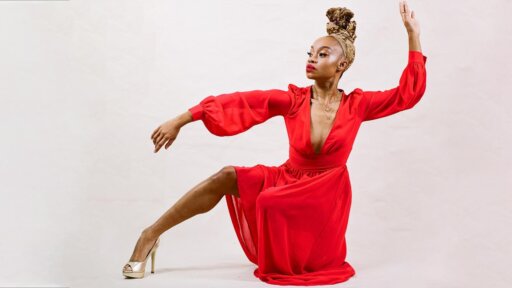TRANSCRIPT
(gentle upbeat music) (camera clicks) - [Gioncarlo] What color are your memories?
Another way of asking, "If you think of me often."
Mine are a feverish orange hue, what a photo director once termed a honey hibiscus haze.
But, do you think of me often?
Some things that I search for in photography and in my writing is the everyday.
For Black life, the everyday has been told through the lens of white photographers, has been devalued, has been exploited in a particular way.
So I'm creating a body of work that tells really simple stories about regular people who are special and unique and have had, like, really fulfilling lives, and that being kind of enough.
(graphics clicking) Okay.
- How you been?
- I'm good.
- Yeah?
- How have you been?
- I'm good.
- Welcome home.
- Thank you.
Feels good to be home, just like fall.
- [Assistant] Are we loaded up?
- All right, this is beautiful.
Don't move.
Three.
Two.
One.
(camera clicks) All right.
- Should I be funny?
- Don't be annoying.
- Okay.
(laughs) (camera clicks) - All right.
Soften it up a bit.
Turn your head a little bit, please.
Eyes right in the camera.
Nice and big.
Beautiful.
Three, two, one.
(camera clicks) I am Gioncarlo Valentine.
I'm a photographer and writer from Baltimore.
When I moved to New York in 2014, I was making a very particular kind of work.
I wanted to photograph fashion.
(calm music) The following year in 2015, when Freddie Gray was murdered, I went to Baltimore for the protests and I just noticed there were cameras everywhere, film crews everywhere.
People were knocking on people's doors.
It just felt really invasive and violent.
All the photographers were white.
I was chanting as a photographer and as a Black person from Baltimore, but the photographers weren't.
They were just kind of focused on the image and I felt a real strong anger and disconnect from that.
That community wasn't being imaged properly.
When Freddie Gray died, the one thing that I was really crushed by was that the only photo that came out of him was horrible.
It was bad quality.
It looked like it was taken, you know, years before on like a phone, and it was it.
And I was like, this is the representation of a person's whole life.
My work started to shift around then, so I went back and started making portraits, thinking about how everybody kind of deserves to have a nice photo of them.
I was offering that service and trying to impose on people how urgent it was to make images.
(calm music) With my photographs, I think the through line is Blackness and elevating blackness and being black and angry and being angry about the ways that Black people are mistreated.
Photographing with care and photographing care is valuable to me specifically because so much of the Black experience is a group of under-resourced people caring for each other, building community together and like pulling together to make something and create a world for themselves that is not just suffering, but that is something else.
(soft mellow music) And I think around 2016, people started to take notice of my work in New York.
Newsweek reached out and wanted me to photograph Faith Ringgold and it would be my first assignment.
She's like a legendary artist.
Got to spend a day learning about her life.
I felt like just having tea with a girlfriend out back.
And I was so proud of that.
And I think I met with the New York Times three or four months later and then I started working kind of from there.
(gentle music) (photographs clicking) (gentle music fades) (wind gently whooshing) Grandma.
- Yeah, baby?
- Come here, please.
Go ahead and sit down.
- [Joan] Oh, you talking about the light light.
Okay.
- And bring your eyes right over here.
Look into the camera for me.
Look straight ahead.
Nice.
Two, one.
(camera beeping) (camera clicks) When we were young, we grew up chronically homeless and my mother was kind of a presence, but she was coming and going a lot and we were going through a lot and it was very unhappy.
Around that time, I used to go to Rite Aid and steal cameras, like steal point and shoot cameras a lot.
(Joan chattering) It was rare that I had the money to get 'em.. but I would like photograph us going to Save A Lot or photograph us like sitting on the porch.
(Joan humming) It, for me, was very intentional just to kinda capture some of that joy that we were feeling in those fleeting moments.
It felt a little bit like stopping the trauma to create ceremony.
(camera clicks) I did what I could do with this sadness.
I ate it, cracked my teeth open chewing it.
It is all I could muster, all that came out when I tried to speak.
(soft somber strings music) (water boiling) Mom, look at the camera and put your glasses on your face.
Thank you.
Beautiful.
I love this hair back.
I was gonna tell you to bring it down, but I think You love wearing your hair in a ponytail.
You know, as a queer person, my family was really supportive, but school was really tough and I think because of my queerness, I was ostracized often.
So I like got lost in television a lot.
Those were windows into another world and I would fall in love with other people's lives.
(gentle ambient music) - You all right?
- Mm-hmm.
- I think a lot about the women who really came to my rescue over and over again when I was growing up.
I know that I simply wouldn't have gotten through these very particular periods.
- [Lolita] Okay.
- On-- there we go.
Okay, she's playful... She's at home.
- No.
- She's-- (laughs) She's feeling young girl in her room energy.
This is cute.
(camera clicks) I was always just very loud and very feminine.
I loved women and I marveled at my mother's beauty.
I thought that her doing her ponytail in the mirror was truly spiritual for me to watch.
(camera clicks) (gentle strings music) (gentle strings music continues) (water gently splashing) (machine beeping) I met Reginald in 2019.
I was photographing Kamala Harris when she was running for president, and we hit it off and for years talked about collaborating together.
In 2023, decided on me accompanying him and his company, Freedom Reads, to various prisons throughout the country to photograph people on the inside.
And this picture that I'm developing now is actually from the first day.
And I did not have a perspective, but I was trying to keep my eyes open to what the culture and the climate was there.
It was terrifying.
I was like very uncomfortable, as a queer person in that space.
I felt very distant from the people that The few men that wanted to be photographed kind of came over to the side, and this guy was very, very lovely, but very stoic and very quiet.
Let me make a portrait of him.
(water gently splashing) I don't know.
It's been a lot to hold.
We photograph people indiscriminately, so we don't know anything about what they've done.
We have no context for who they are.
They simply sign up to come to the event and we make portraits of them.
And we've been able to photograph really remarkable, kind, bubbly, hilarious people who are in prison.
And I know that, you know...
I don't know.
I just found that to be remarkable.
(calm music) When I think of our community's issues, the people who cause the most harm intercommunally tend to be Black men; and if I'm gonna talk about those harms, if I'm gonna talk about toxic masculinity culture and our unique experience of violence in our community because of our histories, I have to kind of focus my camera on the people who are involved.
So I photographed Michael B. Jordan and Jonathan Majors for the New York Times, and they went viral.
The commentary was like rooted in a very bizarre kind of elementary school homophobia of like should men even touch.
And it was weeks and weeks of feeling completely invisibilized, like having my name never spoken.
The context of that work fits within the context of all of my work about masculinity, intimacy, and vulnerability between Black men.
But I think that having a queer photographer would've made it too on the nose or like the image would've had a different life.
It would've been queer already inherently.
And then, Jonathan Majors got arrested for assaulting his partner, and immediately the narrative switched to, "You should stop sharing this photograph.
You should take this photograph down."
It was nightmarish.
It was very depressing.
It was just a strange thing to invisibilize me because I think making me present as the image maker would've facilitated the conversation properly.
And I think that this idea that Black people, Black men particularly have to be perfect in order to have value societally, I think my prison project extends to this idea too.
Because this is the actual place that we banish all of the bad people from society to.
It's so strange the idea that when people go to prison, that it's this cliff that people go off of into a nowhere place, but life happens on the inside.
Love continues on the inside.
Families suffer on the outside.
So I think the desire to like disappear this photo is part of the chorus of the Black American experience of needing to be a perfect person in order to have any real value.
(somber music) Black straight men are a big focal point in my work and I love them, and I love them in my work.
And I love Black women in my work just the same, but it is different, there's a different urgency.
Aww!
Look how big.
Hello.
- He got big from last time you saw him, right?
- Yeah.
How old is he now?
- Six.
- Okay, it's been five years then.
- Yeah.
- How you doing, Quest?
You ready to get some pictures?
You want a banana?
You want some granola?
- What is a granola?
- [Gioncarlo] I don't know how to explain that.
A couple of years ago, I was working on a body of work that was to destigmatize facial tattoos.
I was waiting in line at a fish fry place in Harlem and I saw Jonah and I went up to him and I was like, "Hey, I'd love to make a photograph of you."
He was like, "Yeah, right now, let's do it."
And I was like, "Maybe let's schedule a time.
I don't have a camera."
And so he had to bring Quest, who was only a few months old, with him to the park.
It just became one of my favorite images in my archive.
So I had the idea to make an updated photograph.
Three, two.
(camera clicks) Good.
Hold on.
It feels like what is important that this be a document that is ongoing, that the work is a breathing, living archive, that people are participating and collaborating in the images, that you're building connections that continue for long periods of time.
It's affirming beyond anything technical or like beauty-based.
Quest will grow up with this document and we'll probably photograph him again and again and grow up with an archive of his own.
(camera clicks) (bright piano music) (bright piano music continues) I make an image.
Try to catch my breath again.
I am breathing with my camera.
I'm erupting with the bittersweet, so I keep moving.
I catch a second wind to get away from it all.
(gentle music) (gentle music continues) (Gioncarlo humming) (camera knob clicking) Self-portraiture has been this really quiet spiritual practice almost.
It is a practice of seeing oneself.
There are people who are treated a particular way in society where they don't want you to exist.
They do not want queer people to exist.
They do not want fat people to even be clothed.
People don't even make clothes for fat bodies.
Being constantly told that I'm unbeautiful when I know that I'm beautiful, that I'm unlovable and unloved when I know that that's not true.
It is a radical act to kind of push back on that every chance that I get.
I started this body of work specifically after realizing that I had stopped looking in the mirror, literally.
Like, there was a period of years where I had actually disengaged with the mirror.
I feel beautiful when I photograph myself and that is a practice of like reminding myself that I am incredibly beautiful, that I that I actively go out of my way to care for my body and for myself.
Because it's important for me to know where I have been as an artist.
And it is so important to me that I do not disappear.
I cannot describe how much like myself he made me feel, how inside my body I felt when he called my name.
Gioncarlo, his voice would thunder.
Gioncarlo, a name that I gave myself but that I never felt was suddenly all flesh, was all I could feel around me.
After a moment, silence.
No cars, just sunset.
He called my name and it echoed off the mountains.
I made a small exposure and the earth held its breath.
(camera clicks) (calm music) (calm music continues) (calm music fades) (clapperboard claps)
 Looking at the scope of Gioncarlo’s work leaves you breathless- archives of photographs of moments of real intimacy. Photographs ranging from notable public figures to friends met in the soft shadows of morning light- deep, genuine smiles and longing stares that make each image feel just as intimate as the next. Images that stay with you long after they first cross your eyes. Over the years, Gioncarlo has continually proven himself as a photographer who can make any person feel authentically seen in front of his lens.
Looking at the scope of Gioncarlo’s work leaves you breathless- archives of photographs of moments of real intimacy. Photographs ranging from notable public figures to friends met in the soft shadows of morning light- deep, genuine smiles and longing stares that make each image feel just as intimate as the next. Images that stay with you long after they first cross your eyes. Over the years, Gioncarlo has continually proven himself as a photographer who can make any person feel authentically seen in front of his lens.
